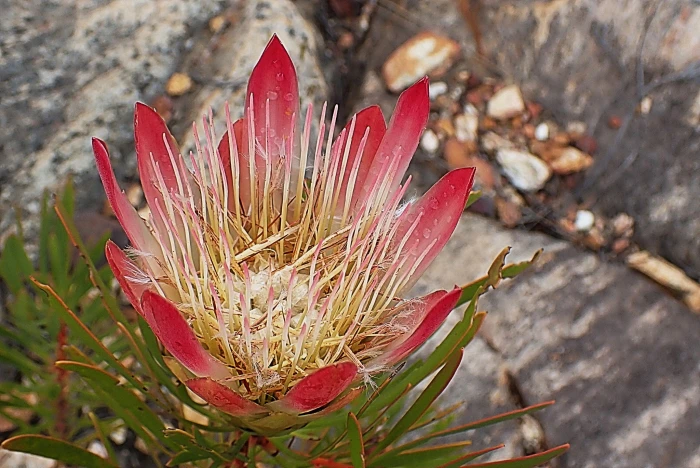Common Sugarbush
(Protea repens)
Common Sugarbush (Protea repens)
/
/

Di Turner
Public Domain
Image By:
Di Turner
Recorded By:
Copyright:
Public Domain
Copyright Notice:
Photo by: Di Turner | License Type: Public Domain | License URL: http://creativecommons.org/publicdomain/zero/1.0/ | Rights Holder: Di Turner | Publisher: iNaturalist | Date Created: 2021-03-27T10:07:06-07:00 |




















































Estimated Native Range
Climate Requirements for Oxnard, California
| This Plant | Your Site | Plant Suitability for Your Location | ||
|---|---|---|---|---|
| • Precipitation | 9" - 53" | 14" | Your precipitation may be insufficient for this plant. Irrigate N" / year. | Irrigate N" / year |
| • High Temp. | 71°F - 93°F | 78°F | Your summer temperatures are normal for this plant. | Excellent |
| • Low Temp. | 29°F - 51°F | 44°F | Your winter temperatures are normal for this plant | Excellent |
This plant should grow well at your location with about N inches per year (Y minutes per month) of irrigation.
Summary
Protea repens, commonly known as Common Sugarbush, is an evergreen shrub native to the fynbos biome of the Cape Provinces of South Africa, where it thrives in Mediterranean-type climates with wet winters and dry summers. It typically grows between 1 to 4 meters (3 ft 3 in to 13 ft 1 in) in height and is characterized by its dense, erect growth habit. The leathery leaves are elongated and the plant is well-known for its striking inflorescences, which range in color from deep red to creamy white and are borne at the ends of branches, often nestled between two growing branchlets. The flowering season extends from late winter to spring, and the flowers are exceptionally showy, attracting pollinators such as birds and insects.
The Common Sugarbush is valued for its ornamental flowers and adaptability, making it a favored choice for wildlife gardens and as a cut flower in floral arrangements. It is also used in xeriscaping due to its low water requirements. In cultivation, it thrives in full sun and prefers well-drained soils. While it tolerates low to medium water conditions, it is sensitive to phosphorus and requires a low-phosphorus fertilizer. Protea repens can be susceptible to root rot if overwatered or planted in poorly drained soils. It is also prone to fungal diseases like powdery mildew. Gardeners should be cautious when planting it outside its native range, as it can become invasive in similar climates.CC BY-SA 4.0
The Common Sugarbush is valued for its ornamental flowers and adaptability, making it a favored choice for wildlife gardens and as a cut flower in floral arrangements. It is also used in xeriscaping due to its low water requirements. In cultivation, it thrives in full sun and prefers well-drained soils. While it tolerates low to medium water conditions, it is sensitive to phosphorus and requires a low-phosphorus fertilizer. Protea repens can be susceptible to root rot if overwatered or planted in poorly drained soils. It is also prone to fungal diseases like powdery mildew. Gardeners should be cautious when planting it outside its native range, as it can become invasive in similar climates.CC BY-SA 4.0
Plant Description
- Plant Type: Shrub
- Height: 10-12 feet
- Width: 10-12 feet
- Growth Rate: Moderate
- Flower Color: Orange, Pink, Red, White, Yellow
- Flowering Season: Spring, Fall, Winter
- Leaf Retention: Evergreen
Growth Requirements
- Sun: Full Sun
- Water: Low, Medium
- Drainage: Medium
Common Uses
Bee Garden, Bird Garden, Butterfly Garden, Hummingbird Garden, Low Maintenance, Showy Flowers
Natural Habitat
Native to the fynbos biome of the Cape Provinces of South Africa, thriving in Mediterranean-type climates
Other Names
Common Names: Suikerbossie
Scientific Names: Protea repens , Protea mellifera , Protea canaliculata , Erodendrum mellifluum , Leucadendron melliferum , Leucadendron repens , Protea mellifera subsp. albiflora , Protea mellifera var. albiflora , Protea strobus , Scolymocephalus mellifer , Scolymocephalus repens
GBIF Accepted Name: Protea repens (L.) L.